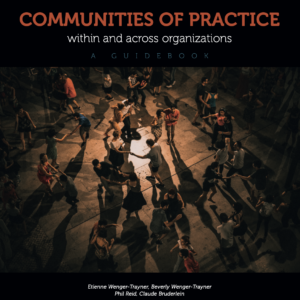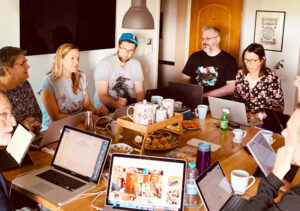NOTICE: There is an updated version of all these FAQs on our new website:
How is a community of practice different from an informal network in regard to social learning?
All communities of practice are networks in the sense that they involve connections among members. But not all networks are communities of practice: a community of practice entails shared domain that becomes a source of identification. This identity creates a sense of commitment to the community as a whole, not just connections to a few linking nodes. Communities and networks are often thought of as two different types of social structure. From this perspective, one would need to ask the question: given a group, is it a community or is it a network? We prefer to think of community and network as two aspects of social structuring, which require different forms of developmental work.- The network aspect refers to the set of relationships, personal interactions, and connections among participants, viewed as a set of nodes and links, with its affordances for information flows and helpful linkages.
- The community aspect refers to the development of a shared identity around a topic that represents a collective intention—however tacit and distributed—to steward a domain of knowledge and to sustain learning about it.
| << What is a community of practice? | What is the difference between communities and teams? >> |
For more information, click here:
For a more precise definition, see our theory page on communities of practice:
For a bit more info, see our general (but brief) introduction to communities of practice and their use in various contexts:
For practical advice on cultivating communities of practice, see our new guidebook:
For workshops on cultivating communities of practice:



I really appreciate you are willing to share your knowledge with the rest of us, the world. Being a student of Licenciatura en Inglés ( that is bachelor degree in English), here in my coutry: Argentina, your findings are really hepful for me.
This is an incredible analysis of the subtle contrast between these two phenomena. I would have hardly been able to so explicitly distinguish one from the other. And also, you’ve gone on to provide us with a clear relationship between the two concepts which, I think, has helped to see why and how we can easily confuse one with the other. Indeed, I’ve found this detailed analysis quite profound especially about the emphasis on identity that a community fosters in its individuals whereas a network operates at the level of ties which are crucial for binding these individuals together. Finally, I’m pleased to say: I will certainly make references to this article in my on-going works as well. Thanks!
Thanks, Batanyi. Glad it’s helpful!
Pingback: Test Four Section One | doriemoore3
Pingback: » Learning in landscapes of practice
Pingback: Blog Post 2. My Practice and Community. | keanemindlab
Pingback: Defining and Evaluating the community of my professional context | Reflective Teaching
the perception is clear about the difference between community and the network. good analysis previewing all the basic points.the explanation which is given is very sensitive it will aware the one who deserves…… soon i am going to implement this concept to my organization with my network hope it will work surely. Thanks Guys to share this important information.. kudos to you all!
Thanks for your kind words. Hope your project goes well.
Pingback: The Big Bet on the Power of a Network and Professional Teacher Communities | The Raw and the Cooked
Dear Team B,
I AM A PROFFEESSOR IN A TEACHET TRAINING AND LEADING A WHOLE FACOULTY AROUND COMMUNITY BUILDING AND CREATIG COMMUNITY NETWORKS ALL AROUND THE WORLD. AND FOR SOMETIME REALLY INVESTIGATING THE DIFFERENCES BETWEEN GROUP COMMUNITY AND NETWORK.YOUR DESCRIPTION IS VERY INTERESTING AND YOU GOT TO THE SAME CONCLUSION I GOT TO.
WILL BE HAPPY TO HEAR MORE AND SHARE MORE IDEAS AND THOUGHTS.
WILL BE HAPPY TO HEAR FROM YOU.
Glad to hear that our distinction reflects your experience. And all the best on your community building.
If I need to cite something from this page in a research paper, do you know whom I should credit as author(s)?
Thank you!!
You should credit Etienne and Beverly Wenger-Trayner (2011) and provide this link. Thank you.
Pingback: What is a community of practice? | Wenger-Trayner
Pingback: Learning in landscapes of practice | Wenger-Trayner
Pingback: Marty Kearns: “Building Networks in Uncertain Times” - Resilience